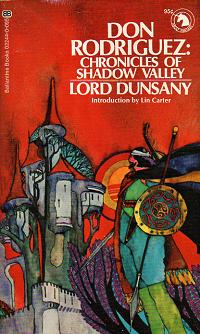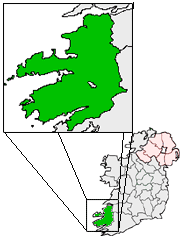
The Curse of the Wise Woman (1933) is a novel by Lord Dunsany, differing from his earlier books by its Irish setting and restrained use of fantasy elements. [1] It won the Harmsworth Award for the best work of imaginative prose by an Irish author.

The Curse of the Wise Woman (1933) is a novel by Lord Dunsany, differing from his earlier books by its Irish setting and restrained use of fantasy elements. [1] It won the Harmsworth Award for the best work of imaginative prose by an Irish author.
The plot concerns a motherless teenaged Anglo-Irish gentleman of the 1890s whose father has been forced to flee the country. Left in charge of the family estates, he uses his freedom to indulge his love of field sports, focusing especially on wildfowl-shooting on a nearby peat bog. There is an extended chapter narrating a magnificent fox hunt, whose trophy, the brush, forms the focus of a poignant moment in the coda, in the narrator's old age. When he discovers that the existence of the bog is threatened by an industrial peat-cutting syndicate he finds no effective ally except an old woman who believes herself to be a "wise woman", or witch. The syndicate is defeated either by her occult powers or by the unaided forces of nature, just as the reader chooses to believe.
Elements of the book had been in Dunsany's mind for some years before he finally came to write it, but it was only repeated encouragement from his wife that finally led him to write the novel. She also induced him to add some love interest to the story. [2] The process of composition, when it finally came, only took 15 weeks, from February to May 1933. The Curse of the Wise Woman was published later that year by William Collins. [3] [4]
The book received excellent reviews on its first publication, and was chosen by John Masefield to receive the Harmsworth Award for the best work of imaginative prose by an Irish author. [5] It stayed in print for some twenty years, and was reprinted in 1972. In his introduction to a 1976 reissue Dennis Wheatley said that it would "appeal to those who love shooting, hunting and magnificent descriptions of the beauties of nature". [6] Mark Amory, writing in 1972, called it "now the best-known and loved of all his work"; he noted that the author's prose was here "eloquent but under control", and that it had "a feeling for the country and country people". [5] The Dunsany scholar Darrell Schweitzer considered it his finest novel. He felt that the Irish countryside "comes across so vividly that the reader is all but transported there", but he nevertheless emphasised the importance of its otherworldly elements: "between the finest magical cursing and conjuring scenes Dunsany ever wrote and the vision of Tir-nan-Og, the book has the feel of the purest fantasy". [7] Both critics were agreed in calling it an unusually autobiographical Dunsany novel. [8] [5] S. T. Joshi called The Curse of the Wise Woman Dunsany's most unified novel, [9] while an anonymous Kirkus reviewer offered the contrary opinion that it fell between the two schools of mysticism and rustic realism. [10]
In 2014 Valancourt Books brought The Curse of the Wise Woman back into print with a new introduction by Mark Valentine.

Edward John Moreton Drax Plunkett, 18th Baron of Dunsany was an Anglo-Irish writer and dramatist. Over 90 volumes of fiction, essays, poems and plays appeared in his lifetime, and a modest amount of material was published posthumously. He gained a name in the 1910s as a great writer in the English-speaking world. Best known today are the 1924 fantasy novel, The King of Elfland's Daughter, and his first book, The Gods of Pegāna, which depicts a fictional pantheon. Many critics feel his early work laid grounds for the fantasy genre.

"The Cats of Ulthar" is a short story written by American fantasy author H. P. Lovecraft in June 1920. In the tale, an unnamed narrator relates the story of how a law forbidding the killing of cats came to be in a town called Ulthar. As the narrative goes, the city is home to an old couple who enjoy capturing and killing the townspeople's cats. When a caravan of wanderers passes through the city, the kitten of an orphan (Menes) traveling with the band disappears. Upon hearing of the couple's violent acts towards cats, Menes invokes a prayer before leaving town that causes the local felines to swarm the cat-killers' house and devour them. Upon witnessing the result, the local politicians pass a law forbidding the killing of cats.

The Dream-Quest of Unknown Kadath is a novella by American writer H. P. Lovecraft. Begun probably in the autumn of 1926, the draft was completed on January 22, 1927 and it remained unrevised and unpublished in his lifetime. It is both the longest of the stories that make up his Dream Cycle and the longest Lovecraft work to feature protagonist Randolph Carter. Along with his 1927 novel The Case of Charles Dexter Ward, it can be considered one of the significant achievements of that period of Lovecraft's writing. The Dream-Quest combines elements of horror and fantasy into an epic tale that illustrates the scope and wonder of humankind's ability to dream.

Darrell Charles Schweitzer is an American writer, editor, and critic in the field of speculative fiction. Much of his focus has been on dark fantasy and horror, although he does also work in science fiction and fantasy. Schweitzer is also a prolific writer of literary criticism and editor of collections of essays on various writers within his preferred genres.

"The Moon-Bog" is a short story by American horror fiction writer H. P. Lovecraft, written in or before March 1921. The story was first published in the June 1926 issue of the pulp magazine Weird Tales.

Beyond the Fields We Know is a collection of fantasy short stories by Irish writer Lord Dunsany, and edited by Lin Carter. The title is derived from a description of the location of the border of Elfland used over one hundred times in Lord Dunsany's best-known novel, The King of Elfland's Daughter. It was first published in paperback by Ballantine Books as the forty-seventh volume of its Ballantine Adult Fantasy series in May, 1972. It was the series' fourth Dunsany volume, and the second collection of his shorter fantasies assembled by Carter.

Don Rodriguez: Chronicles of Shadow Valley is a fantasy novel by Lord Dunsany, issued in the United States under this title and in the United Kingdom as The Chronicles of Rodriguez. The first editions, in hardcover, were published simultaneously in London and New York by G. P. Putnam's Sons in February 1922. The first paperback edition was published by Ballantine Books as the thirtieth volume of its Ballantine Adult Fantasy series in May 1971. It was the series' third Dunsany volume. The Ballantine edition includes an introduction by series editor Lin Carter. It and later editions use the American title.

Fifty-One Tales is a collection of fantasy short stories by Irish writer Lord Dunsany, considered a major influence on the work of J. R. R. Tolkien, H. P. Lovecraft, Ursula K. Le Guin and others. The first editions, in hardcover, were published simultaneously in London and New York City by Elkin Mathews and Mitchell Kennerly, respectively, in April, 1915. The British and American editions differ in that they arrange the material slightly differently and that each includes a story the other omits; "The Poet Speaks with Earth" in the British version, and "The Mist" in the American version.

Verses Dedicatory: 18 Previously Unpublished Poems is a collection of poetry by fantasy author Lord Dunsany, edited by Lin Carter. It was first published in paperback as a chapbook by Charnel House as no. 2 in The Charnel House Chapbooks Series in 1985.

Time and the Gods is the second book by Irish fantasy writer Lord Dunsany, considered a major influence on the work of J. R. R. Tolkien, H. P. Lovecraft, Ursula K. Le Guin, and others.

Five Plays is the eighth book by Anglo-Irish fantasy writer Lord Dunsany, considered a major influence on the work of J. R. R. Tolkien, H. P. Lovecraft, Ursula K. Le Guin and others. It was first published in hardcover by Grant Richards in February, 1914, and has been reprinted a number of times since.

The Last Book of Wonder, originally published as Tales of Wonder, is the tenth book and sixth original short story collection of Irish fantasy writer Lord Dunsany, considered a major influence on the work of J. R. R. Tolkien, H. P. Lovecraft, Ursula K. Le Guin and others.

Tales of Three Hemispheres is a collection of fantasy short stories by Lord Dunsany. The first edition was published in Boston by John W. Luce & Co. in November, 1919; the first British edition was published in London by T. Fisher Unwin in June, 1920.

Fifty Poems is a collection of poetry by fantasy author Lord Dunsany. His first poetry collection, it was first published in hardcover simultaneously in London and New York City by G. P. Putnam's Sons in October, 1929.
Joseph Jorkens is the lead character in over 150 short stories written between 1925 and 1957 by the Irish author Lord Dunsany, noted for his fantasy short stories, fantastic plays, novels and other writings. The Jorkens stories, primarily fantasy but also including elements of adventure, mystery and science fiction literature, have been collected in a series of six books, and were a key inspiration for the "fantastic club tale" type of short story.

The Kerry bog slides natural disaster occurred in the Maghanknockane area of Lyrecrompane, County Kerry, Ireland in August and September 2008. The original bogslide extended over four kilometres on 22 and 23 August destroying an estimated 10 hectares of bog, engulfing two bridges and led to the closure of a section of road; it was reported that it could take anything up to six months to fix the road. The plot of land owned by Moss Moore which inspired John B. Keane's play The Field escaped the disaster by only a couple of kilometres. Comparisons were drawn with the occurrence of an earthquake as it was claimed that a 30-metre (98-foot) wide section was missing from the hill. The event was likened to the 2003 Derrybrien landslide in County Galway.

The Ginger Cat and Other Lost Plays is a collection of plays by Anglo-Irish fantasy writer Lord Dunsany, edited and with an introduction by Darrell Schweitzer. It was first published, in hardcover and paperback, by Wildside Press in 2005.
Bibliography of dark fantasy, horror, science fiction and nonfiction writer Darrell Schweitzer: